
Tiny houses
The idea of minimal living, an international fad, has fallen on fertile soil in New Zealand, thanks to our national housing crisis and shifting ideas about the way we want to live. For some people, a tiny house is the only home they will ever afford to own. Others are stepping off the treadmill of modern life to ask: How much space does a person really need?
Every summer for seven years, Rangimārie Mules would sublet her room in her Auckland flat, swap her high heels for tramping boots, and leave behind a series of policy and research jobs to go bush for three weeks, moonlighting as an instructor on Aoraki Bound, a programme developed by Outward Bound and Ngāi Tahu. Mules helped lead adventures from Anakiwa to Aoraki/Mt Cook, connecting Māori with place and culture.
Every year, she’d be reminded that her ‘normal’ life, her city life, didn’t reflect her true self. Out there, she taught sailing in Queen Charlotte Sound, kayaked across Lake Pukaki, spoke te reo Māori, and told stories of her Ngāi Tahu ancestors. Tramping up to Nōti Raureka/Browning Pass, following in the footsteps of Ngāti Wairangi woman Raureka, the first person to carry pounamu from the west coast to the east, she thought, “I love this side of myself”.
Tiny Department of Conservation huts were home for a night (“you get there after a gruelling day and they’ve got this smell of life, and you just sit there by candlelight and read the visitors’ book all night”) and she lived out of her pack. It gave her a sense of simplicity and connection to the outdoors that her quotidian life lacked. “Eventually I was like, ‘How do I just construct this every day of my life?’”

At the same time, her partner, Jared Hiakita, who is Tūhoe, wanted to take a break from working in the community development sector. He wanted to stop writing reports, stop trying to fix people, and start building something with his bare hands. Then he stumbled upon tiny houses on social media.
“It instantly stoked my curiosity—it seemed like a way to escape a huge mortgage and paying a lifetime of rent, like the very first step on the property ladder,” he says. The couple were living in Christchurch by then. Hiakita did a trade-training scheme to learn some carpentry skills, then started an informal apprenticeship with Park Homes, a company building tiny houses.
Meanwhile, whānau was calling Mules home. She had grown up on family land in the Hokianga, and her parents, two sets of aunts and uncles, and her 95-year-old grandfather were all living there.
Everything fell into place. They would move back to Northland and build a tiny house.
[Chapter Break]
Our housing is in crisis, and rife with contradictions. We are building bigger houses, with more bedrooms, at a time when our households are getting smaller and the birth rate is at a record low.
By some measures, New Zealand now has the most unaffordable housing in the world. For most people, a house costs six times their annual income.
Home ownership is at its lowest rate since 1951, and is expected to fall further. A 2010 government report found evidence of a structural shift—that younger people were less likely to achieve home ownership than ever—and the crisis has deepened since then.
For those who are willing to live minimally, and have a sense of romance about the four walls in which they dwell, tiny houses have become an attractive option.
These are not just small houses. They’re a movement, a culture, a ‘thing’. They have roots in the bach and the caravan, the mountain hut and the worker’s cottage—but they’re also a deeply modern phenomenon.
Online, tiny-house enthusiasts crowd-source clever design ideas, discuss different framing materials, and get advice on dealing with greywater. How-to blogs and video tours get hundreds of thousands of hits. In the United States there’s even a tiny-house reality television show.
People have long lived in small spaces, or moveable dwellings such as caravans and housebuses. In 1854, the American writer Henry David Thoreau famously documented the two years he spent “living deliberately” in a 14-square-metre cabin he built in the woods, and is often invoked as the patron saint of tiny houses in North America. That’s where the recent tiny-house movement began in the late 1990s, and gathered steam in the aftermath of the 2007 to 2010 sub-prime mortgage crisis. It landed here about five years ago.
There’s no definition of what makes a house tiny, but most New Zealand tiny houses are between 20 and 35 square metres. Many are built onto trailers, partly for mobility and partly in an attempt to avoid the high cost of building and resource consents, as some authorities then treat them as caravans.
Making a home in 25 square metres forces people to live simply, and aligns neatly with contemporary trends extolling minimalist, zero-waste lifestyles. But as the housing crisis bites, the appeal of tiny houses is broadening.
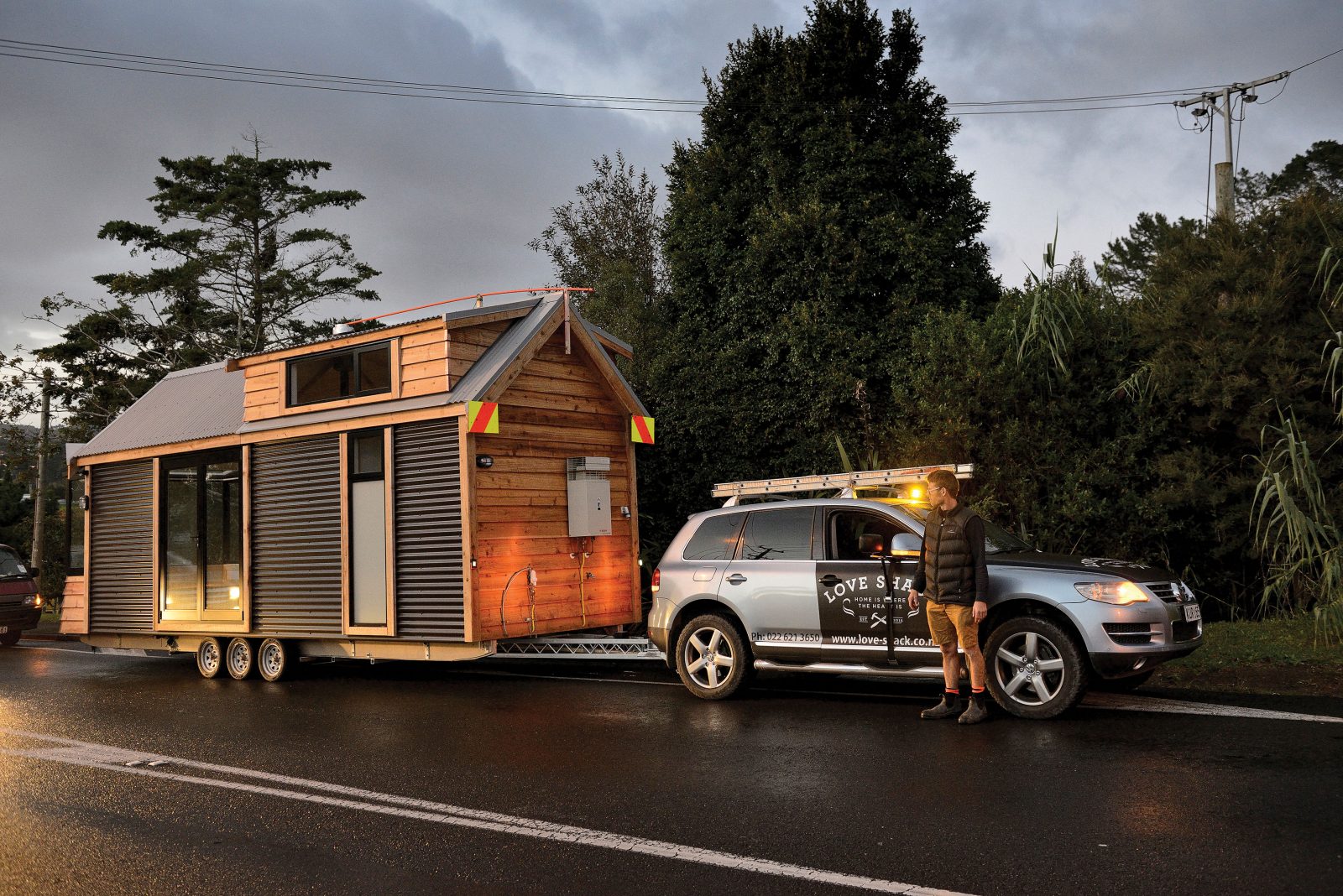

Today, about a dozen outfits nationwide are building them commercially. One company says it has mass-produced 50 single-storey tiny homes so far, and expects to do the same over the next year. But the majority are making bespoke, individualised homes. Collectively, those small operators have sold at least 50 to New Zealand clients, with at least a dozen more being built now. Most companies have been building tiny houses for only a couple of years, and all say that demand is increasing.
So, who are the tiny-house people?
I met some of them at a workshop on Waiheke Island last summer, organised by builder Rosa Henderson. Twenty-two people had signed up for the two-week course, which involved them building two very different tiny houses under the guidance of ten instructors—one house steel-framed and sleek, the other a cute wooden cottage.
When I visit, dozens of people are clambering over the frames, wielding power tools, perching on ladders, staining timber. Although we hold hands in a circle to bless our organic, vegetarian lunch, most of the people there aren’t exactly hippies.
I meet 22-year-old Lisa Stewart, her homemade tool belt hanging off her slender hips. She just wants “something that is mine”, she says, and has spent years perfecting the design of her dream tiny house.
Hutch Walker is 33. I notice a tiny gold cross incised into one of his teeth—he regrets that now, he says. He recently moved home from Australia with his wife and three young children, back to his remote Bay of Islands papakāinga, and he thinks tiny houses could complement the communal facilities there. They’d be affordable places for whānau to come back to, an option more appealing than state housing.
Rachel Archer, a Devonport stay-at-home-mum, was previously the personal assistant of a Russian oligarch in London, and wants to shake off that excess by designing tiny houses. She thinks she could bring a different aesthetic to them, and that high-end tinies made of quality, natural materials will appeal to people with money to spend who want a simple life—or a simple holiday home.

There’s also Brian Rickard, a builder from Waihi, who says he’s sick of making “McMansions and soulless boxes”, and Sally Edgar from Wellington, who has been watching tiny-house videos online for 10 years and is finally taking steps towards building her own.
“At 50, in this housing market, it’s the only way I’ll own a home,” she says.
Several other women at the workshop have been burned after a relationship broke up, losing a home they’d put their soul into.
Again and again, I hear the word freedom. A tiny house represents freedom from debt, freedom from overbearing building restrictions, freedom to take your home with you when your circumstances change.
Over the following months, I speak to other tiny-house enthusiasts around New Zealand, from young single people to families with small children, retirees, investors and builders. But the people who seem to have thought most deeply about why they are building a tiny house, and what it all means, are Jared Hiakita and Rangimārie Mules, and so I go to the Hokianga to meet them.
[Chapter Break]
“We live in the wops,” Mules had warned me, and it was true. To get there I drive north through Waipoua Forest and take a late-afternoon ferry from Rawene to Kohukohu, on the northern shore of the Hokianga. The low sun streams through departing storm clouds and backlights the red-and-white spire of the Catholic church, built by missionaries, at Motukaraka. Auckland feels very far away.
Winding westwards, I arrive right on dusk at the warm, welcoming home of Mules’ parents, where she and Hiakita are staying while they build. The farm has been in her maternal grandfather’s family—the Pākehā side—for more than a century. Two hundred hectares of beef pasture, wetland, beehives and mānuka culminate in a teardrop-shaped peninsula, an ancient Te Rarawa pā site, which points down the long harbour towards the far-off heads.
As a child, Mules went to Panguru Area School, and grew up inspired by some powerful role models. Whina Cooper, then in her 90s, had returned to the Hokianga and lived next to the school. (In 1919, Cooper and her first husband built their own tiny house, a nikau whare, at nearby Te Karaka.)

When the legendary Māori rights activist died, Mules was eight years old, and remembers Panguru coming alive for the tangi as national leaders descended on the small community. “Whina made the same decision I did—she was in Auckland for years and then she decided to move back to Panguru and bring all of her skills home.”
Mules and Hiakita have done the same thing. They love urban life, but the move feels right.
“Life has gotten really easy, and meaningful, and smaller—those are the unintended consequences of moving home and building a tiny house,” she says.
The following morning, they show me their home-in-progress, tucked up against Mules’ parents’ shed.
Hiakita tells me about trailer weight limits and external wiring and structurally insulated panels, revelling in his new knowledge.
“I really loved the idea of building it myself and the learning that comes with that, the skills I’m going to carry with me for the rest of my life.
“As a teacher, you learn strategies, but they’re super contextual and it’s hard to see the results—but building is so tangible, so black and white. You made a mistake? You know about it.”
The house is almost finished—it has a roof, doors and windows, and a beautiful wooden ceiling—but it’s still an empty box. Today, they’re working on the floor, experimenting with different-coloured stains for the jigsaw puzzle of plywood they’re assembling.
Because every centimetre counts, tiny houses reveal a lot about their owners’ priorities. Some have a camp kitchen and a full-sized shower. One I saw had a giant flat-screen television that, at the touch of a button, emerged on a hydraulic arm from a hidden cupboard. Mules and Hiakita’s tiny house will have a three-metre-long kitchen bench made of recycled kauri, and an outdoor bathroom. Moving the toilet and shower outside, says Mules, was a “eureka moment”—a way to make the boundary between inside and outside more porous, to invite nature in.
“I have these dreams of showering with native ferns falling all over me,” she says. “We’ll probably just be careful about not using crappy soaps and let the greywater feed the tī kōuka [cabbage trees] in the swampy bit down there.”
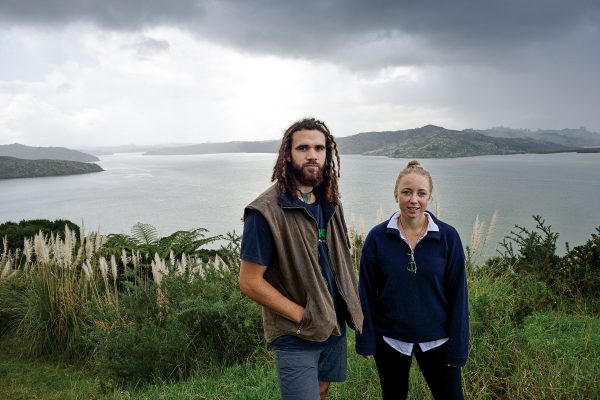
Above the kitchen, reached by a set of stairs, will be a sleeping loft. Its underside will only just clear Hiakita’s 1.9-metre frame. But he’s not concerned about living in such a small space—20 square metres plus five for the loft.
“In my head it’s gonna be sweet as, I’m gonna love it—but I guess I don’t really know,” says Hiakita. Like most millennials, though, he’s spent a decade flatting, living in a series of uninsulated, tiny rooms: “I don’t think it will be much different.”
They are aiming to build the house for less than $40,000, partly to show friends and whānau what’s possible.
“Everyone’s like, ‘Tiny houses are a great solution to the housing issue’, but if it costs $100,000, that’s not a solution,” says Mules. “For the people we know and our communities, that’s still inaccessible. So we’re really trying to put tight parameters on our build and think creatively about using our resources.”
Forty grand may have been enough for a deposit on a mortgage—but that would have constrained them in other ways, says Hiakita.
“The majority of people in the developed world are stuck in this twisted cycle where in order to afford your lifestyle and the place you live you need to work extreme hours until you’re very old,” he says. “And at the end of it all, it’s like, ‘What did that all mean? What was I chasing?’”
This is a common theme of conversations within the tiny-house movement—a rejection of consumerism, debt, waste, and housing choices that don’t really feel like choices: “People are just over it,” Hiakita says.
But he’s aware that not everyone is on board with the idea.
“We talk about this stuff a lot in our social circles, but there is a huge portion of other people out there who are paddling a whole other waka—and there are more of them than there are of us.”
[Chapter Break]
That other waka is more of a container ship, steaming in the other direction.
In 1974, the average house in New Zealand was 110 square metres. By 2010, that had bloated to 199 square metres, and house sizes have dropped only slightly since then.
Big houses need more resources and take longer to build. They cost more to heat, light and clean—and they’re not even what we really want.
“Economists would say people just like bigger homes, but that’s not consistent with the research I’ve done,” says sociologist Kay Saville-Smith from the Wellington-based Centre for Research, Evaluation and Social Assessment (CRESA). “We are producing houses which don’t fit our needs.”
How is this happening? Partly because people buy houses with an eye to capital gains, and there’s a perception that three- or four-bedroom homes are a better investment. But an increasingly significant part of the problem is covenants, says Saville-Smith. Developers use covenants to specify minimum house sizes, and larger houses generally command higher profit margins.
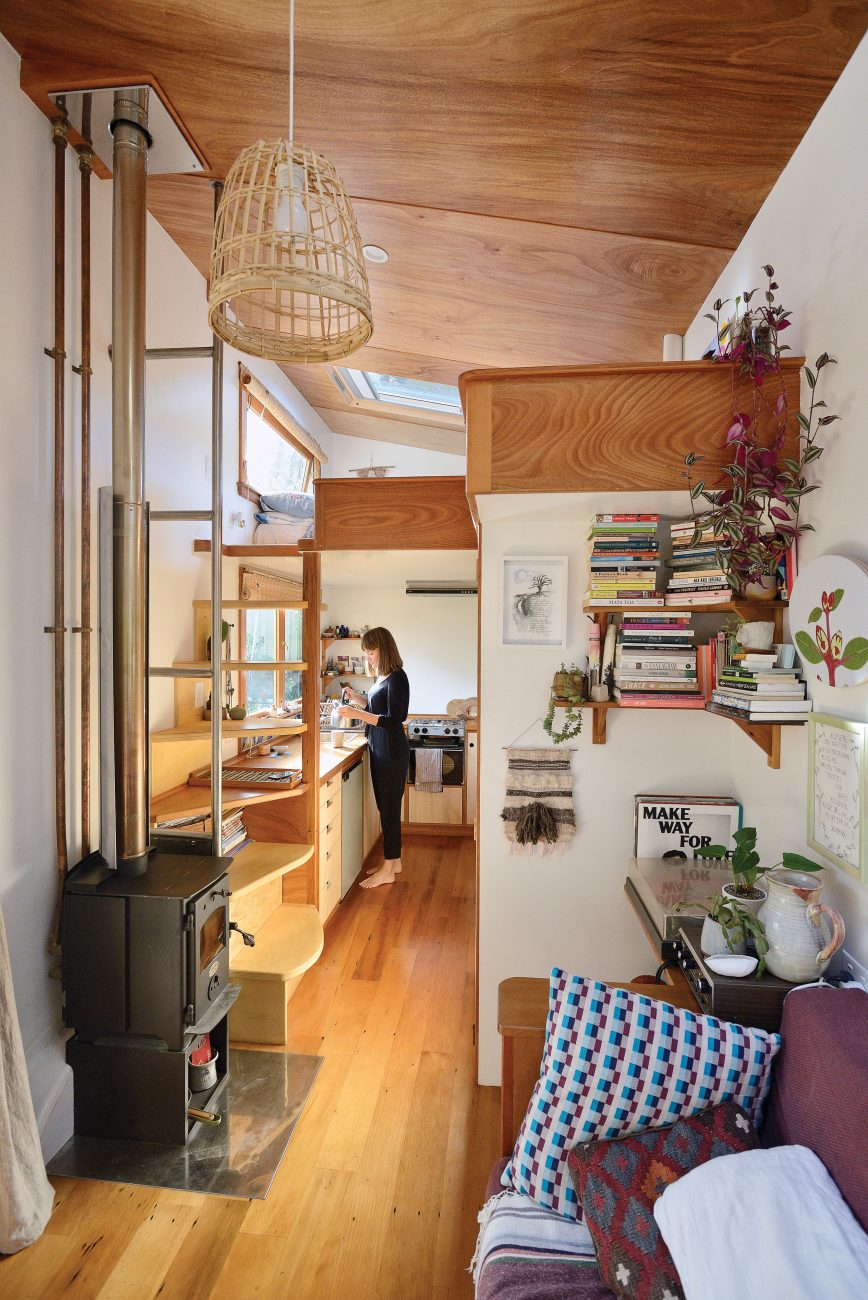
A study by Building Better Homes, Towns and Cities, a government-funded National Science Challenge, is analysing the property titles registered in Auckland over the past three decades.
The figures are still being finalised, but Saville-Smith says it looks like about 55 per cent of Auckland residential titles in 2017 had a covenant—compared with less than 10 per cent in 1980. Very often, those covenants mandate large dwellings, she says.
“The worst I’ve seen is a minimum of 245 square metres. You’ll hear a lot about how affordable housing is affected by planning regulations; that’s a typical public narrative. You don’t hear a lot about the use of covenants—anyone can put them on, but they’re very hard to get rid of.”
The burgeoning interest in tiny houses echoes some of these tensions, says Saville-Smith.
“It reflects a very fundamental sense of disquiet about our homes and our neighbourhoods and the way in which they’re constructed. We need more homes, we need more that are fit for purpose, and that means they need to be a lot smaller than they are.”
Perhaps not truly tiny, though. “My sense is that tiny houses are going to attract the regulatory gaze much more quickly than the use of covenants—I think they are on the cusp of being much more tightly controlled in the future.”
Is a crackdown on tiny houses coming? So far, it seems to depend on where you put one.
I heard of tiny-house dwellers in Christchurch and Waikato getting the go-ahead from councils to stay, while others in Queenstown and Nelson were given notice to leave. Other people who contacted local authorities about tiny homes received contradictory advice, or were bounced from one official to another.
“No one would give us a straight answer,” says Amanda Morrissey-Brown, who contacted Auckland Council along with her partner, Cam Watson, to find out what the rules were.
“They said it was a really grey area, and were super unhelpful and uninterested in talking it through with us.”
Eventually, they decided to build a tiny house on a trailer, following the specifications of the road code.
The couple, both in their mid-20s, are still unpacking when I visit their 20-square-metre tiny house in the suburbs. He’s a geologist, she works in the art world, and they catch the commuter train to the city.
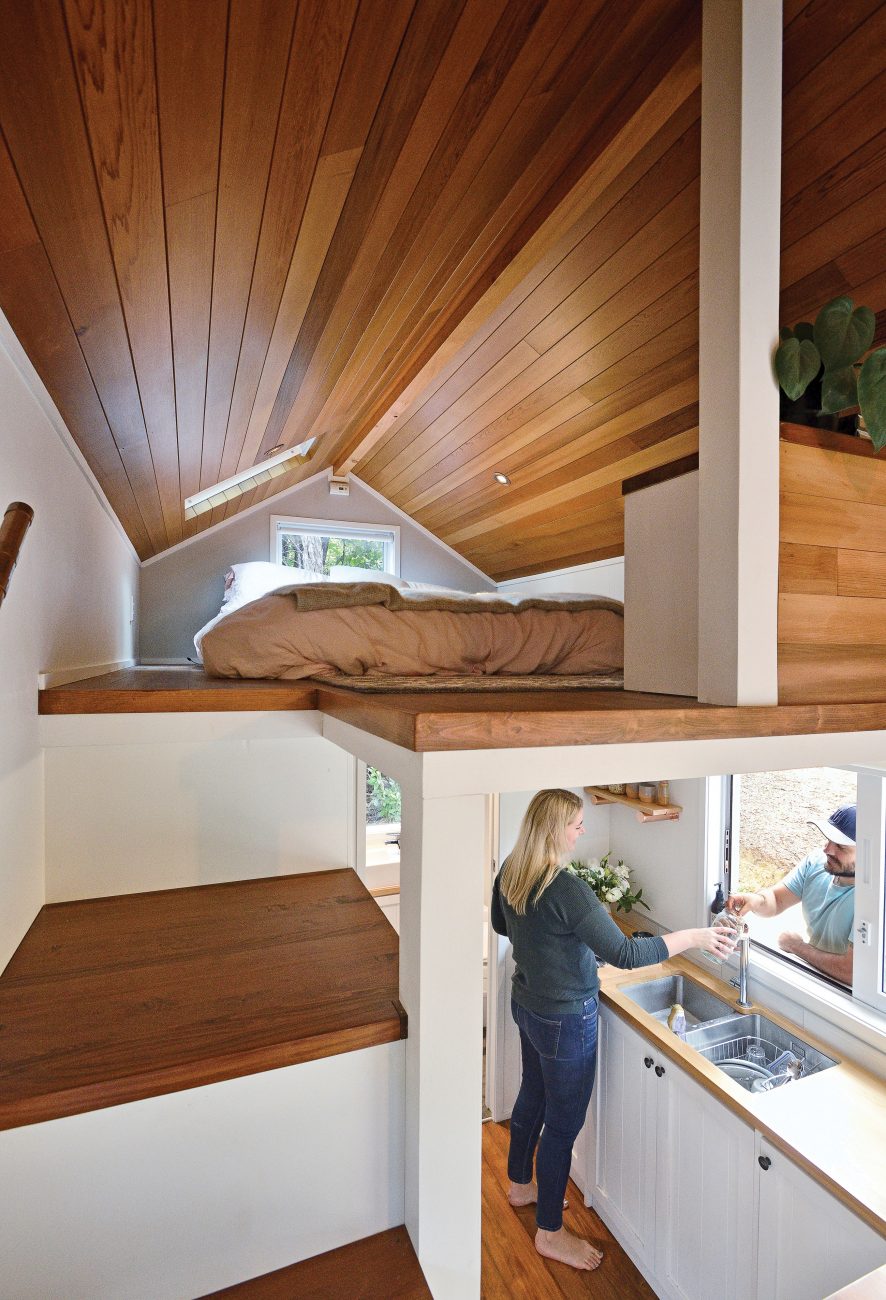
They had a builder make their house, then added their own design touches and a few special elements: cupboard handles from Morrissey-Brown’s childhood home, and recycled tawa flooring that they reclaimed themselves one weekend from a Glen Innes demolition site where Watson was working.
“They bulldoze the state houses and everything just goes to landfill; it’s heartbreaking,” says Morrissey-Brown. “But they let us go in there with crowbars and high vis and in ten hours we had our floorboards.”
The whole thing cost $100,000. In five years, they’ll have paid it off—and if they’re sick of living tiny by then, they’ll sell it and use the money for a deposit on a normal house.
“Basically, it’s like owning a one-bedroom apartment, except it’s on a trailer,” says Morrissey-Brown.
For now, they’re renting a scrap of land from a family friend, their little wooden home nestled in a large backyard behind the main house, which is mostly uninhabited.
“It works well because they get some income—and someone to keep an eye on the place.”
Their parents have been supportive, but they’ve faced some overt animosity from family and acquaintances.
“My uncle was like, ‘Well, I don’t want to live in a small space’, and I was like, ‘You don’t have to’,” says Morrissey-Brown. “People don’t like change, I think—they say, ‘Why can’t you just live in a normal house like everyone else and not make waves?’ I think people feel threatened by ideas like this, because it reflects on their own lifestyle.
“But for us and our friends, unless you’ve got wealthy parents, getting a home is just not a reality. With a tiny house, you can use it as a stepping stone, and even if it’s just for five years, you can actually put money towards something, rather than just paying off someone else’s mortgage.”
There are backyards like this all over New Zealand. More accommodating rules about tiny houses in urban areas could open this space up and help create housing for people who need it.
Last year, CRESA research found that at least 180,000 extra homes could be created by partitioning existing dwellings or adding extra units—a vast resource of land sitting right under our noses.
Today, we are living more intergenerationally, too. In 2013, 11 per cent of the population lived in extended-family households—up 57 per cent from 2001. Tiny houses, or extra units, could house teenagers, elderly relatives, or the next generation of a family.
In 2017, anticipating this, Nathan Orr set up Landshare, a website aimed at connecting landowners with those looking for a spot to park their tiny home. At the age of 27, and at almost two metres tall, Orr has already built his own tiny house on wheels, and extensively researched the regulations around them.
“You can’t say that they don’t require consent, and you can’t say that they do. Every council is different in their stance on it. It’s a massive can of worms.”
[Chapter Break]
On the north side of Auckland’s harbour bridge, a few hundred metres from the motorway, Shane and Alison Norton’s tiny house sits in the middle of Northcote suburbia. It’s adorable—olive green with white trim, matching furnishings, a removable deck.
But they’re not allowed to use it for a sleepover, much less live in it. After neighbours complained, Auckland Council told the Nortons that if their tiny house on wheels is inhabited, it counts as a dwelling, not a vehicle (“If you lived in your car they’d class it as a building,” says Shane), and requires building and resource consent. He was also told that, under the Unitary Plan, studio dwellings must have a minimum internal floor area of 30 square metres.
“We’ve got a beautiful tiny house but it’s basically a glorified beer fridge,” he says.
He estimates it will cost about $60,000 to get building and resource consents for the $80,000 house. They’re planning to jump through all the hoops in order to provide a model for others.
“We can say, ‘Here’s the process we’ve gone through, don’t make the mistakes that we did, and if you’re going to build one of these in Auckland, here’s what you’ve got to do.’
“It’s going to be an absolute minefield, but we’ll try. If we can pull this off, we’ll build another one with our kids.”
When I rang Auckland Council to clarify all this, Ian Smallburn, the general manager of resource consents, told me that you might need resource consent for your tiny house or you might not, depending on zoning—but you shouldn’t need a building consent if you’re on wheels and off the grid.
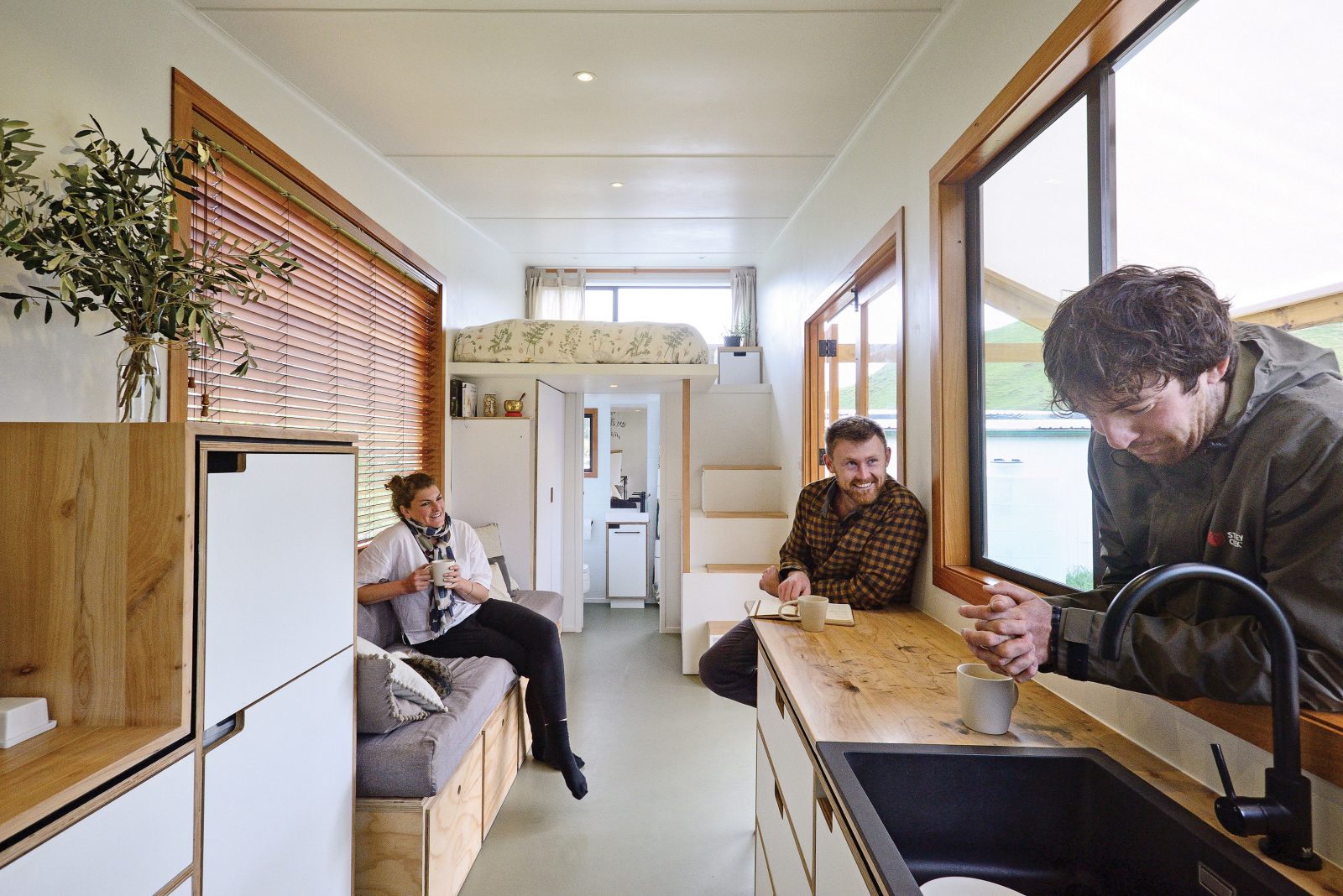
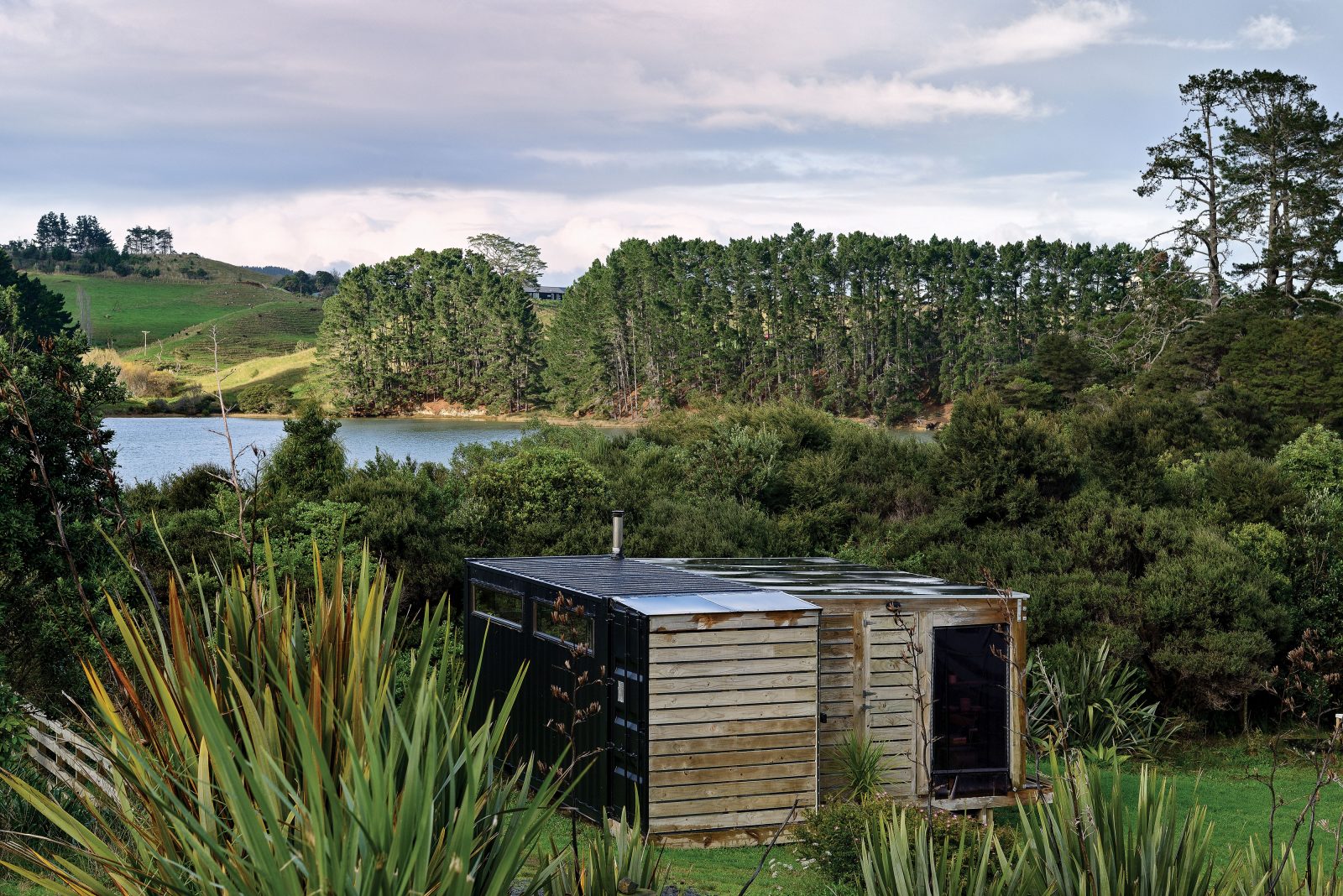
Then I spoke to Jeff Fahrensohn, who manages the council’s team of building inspectors. He told me the opposite. Even if a structure has wheels and is capable of being moved, he says, under the Building Act it can be considered a building if it’s occupied long term. “The bottom line is we’re looking at the health and safety of people using these buildings,” says “For small houses it’s more about sanitation and structure—making sure they’ll withstand the first storm that comes across Auckland.”
Building consents typically cost about $5000. The biggest expense is the development contributions that are often imposed by the council. After all, someone has to pay for new infrastructure costs—if tiny houses were mushrooming up in the suburbs with no controls, existing waste and stormwater systems could become overloaded: “We’ve squeezed the population of Hamilton into Auckland in the last four years,” says Fahrensohn. Development contributions also fund community facilities such as libraries, swimming pools and bus services.
Auckland Council is currently reviewing its contributions policy, and says it welcomes public submissions on whether tiny houses should be treated differently.
The senior council representatives I spoke to emphasised that their doors were open and they were willing to consider innovative solutions. In reality, that’s not always the case.
Entrepreneur and business consultant Rebecca Mills has plenty of experience navigating policy, but even she ran into a dead end.
[sidebar-1]
Sick of her uninsulated “Grey Lynn fridge”, she and her partner decided to design a sustainable, off-the-grid tiny house, and put the plans online for others to use freely—their contribution to a housing-crisis solution. Then they found it would be subject to the same red tape and infrastructure costs as an on-the-grid home.
Tiny houses are a new phenomenon in New Zealand, and Mills believes that our existing laws aren’t fit for purpose. She thinks we need new planning rules and design guidelines specifically for tiny homes that take into account their minimal impact on the environment and neighbouring properties.
“I don’t think it should be the responsibility of every individual to make their case to the council,” she says. “We just need to create guidelines that make sense and are grounded in values.”
[Chapter Break]
People who are willing to live in 25 square metres will probably always be in the minority. But the trendiness of the tiny-house movement is helping to drag ideas about smaller, more thoughtful design into the mainstream.
Jeremy Hansen edited the architecture magazine Home from 2005 to 2016, and witnessed a shift in readers’ attitudes as the housing crisis became more acute and building costs went through the roof.
“People loved the idea of paring back while on holiday, but it’s taken them a long time to accept that the sense of liberty and lack of complexity they experience on holiday can also be created in their own home,” he says. “A well-designed smaller space can feel much more satisfying for people than a poorly designed large one, no matter how much money you throw at it.”
In 2015, Hansen started producing special issues of the magazine focused on small homes. Unexpectedly, they became bestsellers.
“Living simply was striking a mainstream chord among an audience that was previously believed to be full of affluenza. So I think we’re seeing an attitudinal as well as a financial shift.
“The appetite for debt is reducing, and tiny houses represent the idea of living debt-free, as well as a kind of intimacy with the landscape, and a humane kind of warmth which is missing from a lot of homes these days.
“It felt like a necessary corrective because homes in the United States and Australia and New Zealand were becoming so bloated. The tiny-house movement is a really seductive counterpoint to that bloat and makes people feel like there are options other than sprawl and excessive resource use. It does feel like a really healthy protest.”
But Hansen doesn’t see tiny houses as an answer to our most urgent housing needs.
“I can appreciate that they’re beautifully handcrafted objects, and the lessons they teach about living with less, but they’re kind of a philosophical point rather than a practical large-scale solution.”
Yet philosophy is the whole point, according to architect and former University of Auckland lecturer Tony Watkins.
I visit Watkins, as he instructs by email, “when the sun is shining and the wind is in the west”. Actually, it’s even better than that. It’s one of those still, sparkling May days when the Hauraki Gulf is luminous and everything seems soaked in brilliance.
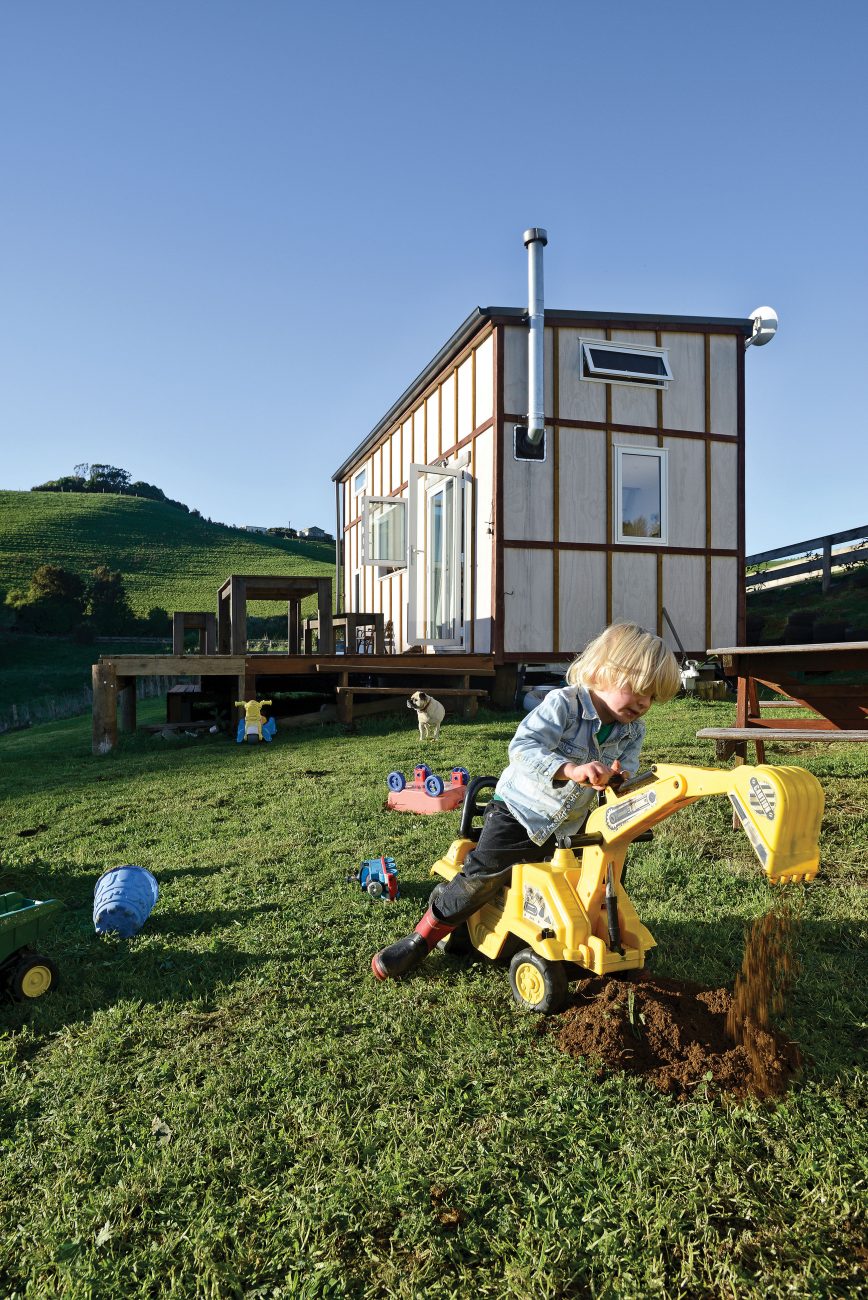
Half a century ago, Watkins began building his own house at Karaka Bay in the eastern suburb of Glendowie. A strange and beautiful structure that’s easy to miss from the beach, it seems to clamber up the cliff and disappear among the pōhutukawa. He would approve of Mules’ outdoor shower—his is open to the trees and fantails: “You have to feel sorry for all the other people in Auckland showering in a box.”
It isn’t a day for sitting inside, though, so we walk along the beach, the tide receding as we talk—which, it turns out, is entirely in keeping with Watkins’ philosophy of architecture.
Architecture should intensify our experience of nature, not shelter us from it, he believes. Before building anything, he says, people should ask: “What is the least possible amount of architecture I can get away with?”
“We start off with this amazing world—the sea, the air, the light—look at this today! Surely—isn’t it good to be alive? If you said, ‘Let’s enclose ourselves in some architecture and hide it’, I would say, ‘Don’t be so stupid’. Too much architecture gets in the way.”
We used to understand this, he says. “The classic New Zealand tiny house was the bach. What was important about the bach, wherever it was, was the landscape. You loved the fishing, you loved the gulls—this is what you went for. So when you built a bach, it was a tiny house. It was the least possible amount of architecture. Now we have huge beach houses and we’ve completely lost what a bach is.”
[sidebar-2]
For Watkins, this isn’t just nostalgia—it’s a question of morality. Tiny houses represent modesty and environmental responsibility, but ending housing’s obesity epidemic will require a seismic shift. He’s been advocating to Housing and Urban Development Minister Phil Twyford that people should be able to build houses of less than 40 square metres without requiring consents (currently, dwellings over 10 square metres must be consented).
That would enable and empower a nation of owner-builders, he says. He’s a passionate advocate of people building their own houses—getting a professional to do it, he declares, is “like getting someone else to make love for you”.
His hope is that the next decade will see an upsurge in small houses—“until, if you build a big house, you’ll be embarrassed about it”.
[Chapter Break]
Back in the Hokianga, Mules takes me over the hill in the farm vehicle to meet her 95-year-old poppa. After World War II, Bill Guest returned from the battlefields of Italy to family land at Panguru. In 1952, he married Nāni Ellison, a Ngāi Tahu nurse, and built a small house overlooking the harbour.
He’s still there, growing veges and helping bring in the day’s catch. Over a cup of tea, he tells me about building his house: milling the macrocarpa his grandmother had planted, floating the logs down the harbour, collecting sand for concrete from the beach and putting the plaster on with a wet sock.
I ask him what he thinks about his granddaughter’s tiny house. “It’s not bad,” he says. He isn’t too sure about the sleeping loft. “When you’re eight months pregnant it’ll be hard to go up those stairs.”
On the way back down the gravel drive, we run into the neighbour at the letterbox.
“How’s that little house of yours going?” she asks.
“We’re putting the floor in now,” says Mules. “Don’t worry, we’ll invite you over for a wine when it’s done.”
The whole community is fascinated by the project, Mules says.
“Down Panguru they’re like, ‘You gonna have an open home so the kids can see it?’
“People love that we are building our own house. I think it’s because we’re quite nostalgic as a culture. We’ve got these core values about who we are as Kiwis—like the whole DIY thing—but they’re not necessarily lived.”
Mules’ father, uncle and cousin helped with the fencing, and Hiakita’s father, whom he hadn’t seen in four years, showed up just at the right movement to help make the driveway.
“We just let him loose on the digger,” says Hiakita. “He’s like a master digger driver—he’s driven trucks and excavators all his life and he had this wealth of knowledge. It was the first time for a long time as an adult that I was able to connect with my dad.”
For New Zealanders of Bill Guest’s generation, building your house was unremarkable. But we’ve come so far from those roots. Watkins would say we’ve lost the love for our homes, become disempowered and disconnected. Our houses—if we can afford them at all—have become commodities and encumbrances, trapping us in debt, tying us to meaningless jobs, taking hours to clean.
Tiny houses are a way of taking back some of that power. For Hiakita and Mules, it’s connected to tino rangatiratanga—sovereignty and self-determination—and they are already feeling its effects.
“I reckon I’m a way better person now than I’ve ever been,” says Hiakita. “I’m happier, I’m more socially confident, less anxious, less stressed—and it’s because of this journey we’re on. It’s allowed me to strip away the things that create burdens for me to carry, to be more rooted in who I am.”

When their house is finished, it’ll be installed in a sunny, north-facing spot near a tōtara grove, just out of sight of the in-laws. Mules can already imagine the driveway lined with carved pou, her ancestors on one side, Hiakita’s on the other.
“We’ll be using our ancestral connections in everything that we do, so we can be like, ‘I’ll race you to Tahu Pōtiki’, or, ‘Go and get the kūmara down by Hinepūkohurangi’.
“We want to create the kinds of things we all missed out on growing up—cultural landscapes that are teeming with life and history.”
Living in a house on wheels also means living more lightly on the land—occupying and caring for it rather than staking a claim.
“We trace our lineage all the way back to the gods, to Papatūānuku and Ranginui,” says Hiakita. “The earth is our ancestor, and if you look at it from an evolutionary point of view, that is completely legitimate—we ascend from the earth, we evolved from bacteria and exploding stars. What we’re doing is an attempt to live in a way that we tread more lightly on Papatūānuku, our mother earth.”
Tiny homes challenge the assumption that the bigger the house, the more life you can fit in it. Living in a small, warm, dry space that’s your own, without a large debt, might instead allow more space to grow and flourish around it. These houses are allowing people to live in accordance with their values, and in a housing market that often feels like it offers no choices, they’re giving people a sense of community, autonomy and freedom.
“Imagine once we’ve moved in and our gardens are fully established and we’re living off the land in a house we built ourselves on the land that we shaped ourselves,” says Hiakita. “That’s what I’m mostly looking forward to, the ability to live the life that we choose to live.”



















